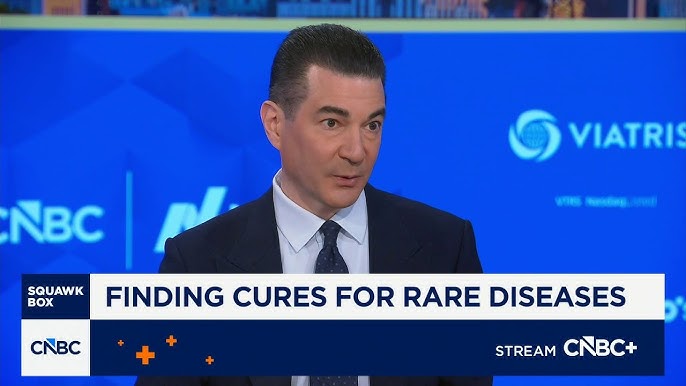
Dr. Scott Gottlieb on Finding Cures for Rare Diseases
Former FDA Commissioner Dr. Scott Gottlieb joins ‘Squawk Box’ to discuss the ongoing research and efforts at the FDA to find cures for rare diseases.…
Thought Leader: Scott Gottlieb

What if we had a new cold war — and we were the Soviets? That was the question I found myself asking during this week’s Asia-Pacific Economic Cooperation summit, the highlight of which was the long-anticipated meeting between Chinese President Xi Jinping and US President Joe Biden at Woodside, California, south of San Francisco.
My question goes against the grain of current conventional wisdom, which gives little credence to Xi’s old slogan that the US is in decline, and China is on the rise (“dong sheng, xi jiang” — “the East rises, the West falls”). Given the surprising strength of the US economy and the sputtering recovery of China’s from the restrictions of “zero Covid,” some commentators have suggested that, on the contrary, it is the West (or at least the US) that is rising economically, while China is falling.
Perhaps to reinforce this narrative, would-be presidential candidate and current California Governor Gavin Newsom organized a long-overdue cleanup of San Francisco, the once-lovely city that he and his fellow Democrats have turned into a dystopia with such absurd policies as “injection sites” for junkies to do illegal drugs, effective decriminalization of shoplifting and officially sanctioned shanty towns. This effort was not thought necessary for the people who live in northern California and pay the taxes that make dystopia possible. But with the leader of the Chinese Communist Policy coming to town, Newsom & Co. knew what had to be done.
You know it’s a cold war summit when there’s automobile one-upmanship. The Chinese president showed up in a fancy electric limousine manufactured by Hongqi (“Red Flag”). Not unimpressed, Biden likened it to his armored Cadillac, which he calls “The Beast.” Fifty years ago, Richard Nixon presented Leonid Brezhnev with the keys to a dark blue Lincoln Continental during the Soviet leader’s visit to the US. (Nixon recalled in his memoirs being taken for a terrifying spin in the vehicle at Camp David. Brezhnev drove the way he drank: hard.)
Similarly, you know the Chinese are making nice when they offer pandas to the local zoo.
Pandas have long played a part in Sino-American relations, going back to Madame Chiang Kai-shek’s gift of two to the US in 1941. Mao Zedong sent a pair to the Washington National Zoo soon after Nixon’s visit to Beijing in 1972. Nothing says China loves you like pandas.
Cold war superpower summits are so choreographed as to resemble the royal pageants of medieval Europe. This often leads to unintentional comedy. Everyone regarded Brezhnev as something of a rube when he came to the US in 1973. He wore two watches, one on Moscow time and one on Washington time, to help him manage his jet lag. But, as Henry Kissinger recalled in his memoirs, the Soviet leader “kept forgetting whether Moscow was ahead of or behind Washington.” Despite the watches, Brezhnev repeatedly messed up the White House staff’s meticulously planned timetables.
Yet Brezhnev’s erratic timekeeping was a welcome distraction for a beleaguered administration. At that time, it was the US that seemed to be losing the Cold War — its president already being dragged down the Via Dolorosa of Watergate, its Indochina policy unraveling, its intelligence community oblivious to the war that Egypt and Syria would launch against Israel four months later.
One could hope, as Kissinger did, that the Soviet system would crumble first. “The major, long-term question,” he wrote to Nixon before Brezhnev’s arrival, “is whether the Soviets can hold their own bloc together while waiting for the West to succumb to a long period of relaxation … Certainly, our chances are as good as Brezhnev’s.” But that was a somewhat forlorn hope in 1973.
Détente in this context was all about playing for time as the US sought to recover from the disaster of Vietnam. Nevertheless, time could not be bought for nothing. Despite the comic touches, the June 1973 summit had at least some substance. The two presidents signed an Agreement on the Prevention of Nuclear War. Nixon listened politely as Brezhnev inveighed against the Chinese. When the party moved on to San Clemente, California, there was an impromptu late-night Soviet proposal for a secret Middle East peace plan. There was also desultory talk of mutual reductions of troops in Europe.
Somewhat similar conversations took place in California last week, but by 1970s standards they were about peripheral issues. According to the White House’s official read-out, the US and China made progress in five areas. First, they will resume high-level military-to-military communications, which were put on hold after former House Speaker Nancy Pelosi’s visit to Taiwan in August 2022. Second, they will set up a bilateral counternarcotics working group to curb the illicit export of fentanyl to the US. Third, they will address the risks arising from advances in artificial intelligence. Fourth, they will increase the number of commercial flights between China and the US and expand “people-to-people” as well as business exchanges. Finally, they will cooperate more closely tackling climate change.
All very worthy sounding. The striking thing, however, is how thin this agenda is in comparison with the détente agenda of 1973. Today’s superpower leaders might productively have discussed nuclear arms control or peace in the Middle East, as their predecessors did half a century ago. Indeed, that would have been a much better use of their time. But no.
In the Chinese read-out, unlike the American version, Xi called on the US to show “in concrete actions” that it does not support Taiwan’s independence, to cease sending arms to Taiwan, and to accept Taiwan’s “peaceful reunification” with China as “inevitable.” The US side offered no comment. The Chinese statement also condemned the US for using export controls, investment reviews and unilateral sanctions against China. Again, no comment.
In short, the really significant thing about the Xi-Biden meeting was what wasn’t discussed, not what was. The summit thus left Cold War II pretty much where it found it. This was détente lite.
If détente is mainly about playing for time, whose side is time on in Cold War II? After more than a decade when the conventional answer was “China’s,” we now appear to have reversed our view. Growth in income and consumption may be back to trend, but China has fallen behind the US in dollar terms. China’s GDP was 76% the size of the US’s in 2021, on a current dollar basis. It fell to 64% in the third quarter, roughly where it was six years ago. According to the International Monetary Fund, Chinese growth will average just 3.9% over the next five years.
The big drags are a persistently low fertility rate (down to 1.1 lifetime births per woman) and a slump in the real estate sector, which has left local government finances in a deep hole. Overall, the Chinese growth model is over-reliant on fixed-asset investment and, with debt piling up, returns are diminishing and foreign investors are exiting. Chinese private equity is in the doldrums.
The Chinese yuan remains an also-ran as a reserve currency. And, in view of the weakened state of many banks, a financial crisis in China is now a serious risk. Moreover, China lacks the fiscal room to address these problems. The result is minimal support for the economy and a downward slide in the currency.
Why all this has happened is a matter of debate, though there is a general agreement among Western economists that not enough has been done in recent years to increase consumption as a share of GDP. The critical point is that US policies of decoupling and “weaponizing interdependence” merely pile on external pressure.
On the other hand, China is now without question the workshop of the world — not to mention the arsenal of autocracy. As Keith Bradsher pointed out in the New York Times earlier this month: “China has already built enough solar panel factories to supply the entire world’s needs. It has built enough auto factories to make every car sold in China, Europe and the United States. And by the end of 2024, China will have built in just five years as many petrochemical factories as all of those now running in Europe plus Japan and South Korea.”
Those are stunning facts. And there are more. China builds 46% of the world’s ships. By 2026, it will produce 42% of the less-advanced semiconductors essential for modern appliances. Most electric car batteries are made in China.
This is why talk of decoupling economies is unrealistic. Since 2017, the share of American imports that come from China has declined by just 5%. Apple still produces the vast majority of its iPhones there. It is also why talk of our having passed “peak China” is almost certainly wrong. As Martin Wolf of the Financial Times has pointed out, in 2022 China’s gross domestic product per head (calculated on the basis of purchasing power parity) was 28% of US per capita GDP, and roughly half of Polish per capita GDP. Those who now say that China has fallen into the middle-income trap are implying that the Chinese cannot get to where Poles are today by the 2040s.
Meanwhile, the US itself looks on closer inspection more and more like “late Soviet America,” a phrase Princeton’s Harold James coined in 2020. There’s a soft budget constraint, in that the US federal government is issuing $776 billion in marketable debt per quarter to fund a deficit running at around 7% of GDP — a shocking number at a time of near-full employment. According to Bloomberg, annualized interest payments on the federal debt exceeded $1 trillion at the end of last month — a figure that has doubled over the past 19 months. This quarter, for the first time since World War II (with the sole exception of the first quarter of 1998) interest payments will exceed defense spending.
Like the late Soviet Union, the US is a gerontocracy. The president turns 81 tomorrow. His principal rival for the presidency, Donald Trump, celebrated his 77th birthday in June. The average age of senators is 64.
And, as in the late Soviet Union, citizens are disillusioned. As Greg Ip of the Wall Street Journal pointed out earlier this month, there is a huge disconnect between the objective performance of the US economy and public dissatisfaction. The labor market is strong. Headline consumer price inflation is down to 3.2%. In real terms, the median household’s wealth after inflation is up 37% since 2019. And yet just 37% of voters approve of Biden’s handling of the economy.
A recent New York Times poll of swing states must have made Democratic strategists choke on their avocado toast:
Voters under 30 … said they trusted Mr. Trump more on the economy by an extraordinary 28 percentage-point margin … Less than one percent of poll respondents under 30 rated the current economy as excellent, including zero poll respondents in that age group in three states: Arizona, Nevada and Wisconsin.
Almost as astounding was the poll showing that 22% of Black voters would support Trump in a rematch against Biden.
The collapse of the Soviet Union upended geopolitics, creating the delusion in American minds that the world was “unipolar,” a nonsense word. To an extent that is only slowing dawning on Europeans and Asians today, Donald Trump’s re-election would effectively end the pax Americana. Trump has long regarded US allies as spongers and free riders. US allies should be planning now for the scenario of his pulling the plug on aid to Ukraine and insisting on a peace that would entail Ukraine ceding territory to Russia. America’s enemies certainly are.
On the other hand, no one did more than Trump to shift US policy toward China from accommodation to confrontation. Xi must therefore weigh carefully how to play the next 12 months, which may be the concluding phase of Biden’s presidency, because he cannot be sure how the unpredictable Trump might respond to the move Xi is clearly contemplating.
That move is not to invade Taiwan, as some American planners seem to expect, but simply to blockade it. This is an operation the People’s Liberation Army and Navy are rehearsing on a regular basis. Beijing sent 336 aircraft to the edges of Taiwanese airspace in September alone. According to Washington Post:
On Sept. 17, a record 103 Chinese warplanes flew near Taiwanese airspace in a 24-hour period … China sent a drone all the way around Taiwan for the first time in April, and this has quickly become a regular maneuver … Chinese aircraft carriers are making themselves at home on the other side of the island, in the Pacific Ocean … There, they launch jets at Taiwan’s east coast and practice repelling the United States should it one day come to defend Taiwan …
For some months, I had been worried that, despite reassuring words from my Chinese sources, a plan was being hatched in Beijing to impose such a blockade in January, using the Taiwanese election to furnish a pretext. But the news that two opposition parties are joining forces to challenge the current government’s candidate, Vice President Lai Ching-te of the Democratic Progressive Party, may reduce the risk of such a scenario.
Lai is Beijing’s bête noire because of remarks he made in the past that implied support for Taiwanese independence. If he loses to a candidate with a more conciliatory stance towards Mainland China, Xi may conclude there is no need to a risk a showdown. (Beijing has other options, too, and my Bloomberg Opinion colleague Hal Brands recently laid out five of them in detail.)
Yet there is another political variable, and that is what is going in Beijing itself. Rumors swirl in the Chinese capital. One is that that Qin Gang — the former ambassador to the US and foreign minister, who disappeared this summer amid rumors of an affair with a TV presenter — is dead. Another is that former Defense Minister Li Shangfu, who was fired last month, had been found guilty of “treasonous” missile intelligence leaks. (The leadership of the PLA Rocket Force, which oversees China’s nuclear arsenal, was also purged in August.) And then there are rumors about the surprising death of former Premier Li Keqiang at age 68, and about the poor state of Xi’s own health.
Perhaps there is no pattern in the tea leaves. Or perhaps Qin Gang and Li Shangfu made the mistake of opposing a high-risk move against Taiwan. It is worth noting that back in June, the latter said that “a severe conflict or confrontation between China and the US will be an unbearable disaster for the world.” Perhaps Xi is in more of a hurry to settle the Taiwan question than anyone in San Francisco last week understood. And perhaps he and Putin were discussing, when they met in Beijing last month, how propitious the circumstances now are, with the US preoccupied by one war in Eastern Europe and another in the Middle East.
In a cold war there are two ways of losing. One is internal collapse. The other is that you become like your enemy. “Convergence” was something people worried about in the 1970s, when it seemed as if the imperatives of espionage and the arms race were causing the US to develop a national security state similar to the Kremlin’s.
The equivalent phenomenon today, as N.S. Lyons points out in a brilliant essay, is that “both China and the West, in their own ways and at their own pace, but for the same reasons, are converging from different directions on … the same not-yet-fully-realized system of totalizing techno-administrative governance.”
What makes a superpower summit at once sinister and comical is this uncanny sense that the two superpowers are not quite the polar opposites they purport to be. Remember: if the Cuban Missile Crisis repeats itself over Taiwan the side imposing the blockade will not be, as in 1962, the US. It will be China. In the Taiwan Semiconductor Crisis of 2024, we would be the Soviets.
It is, to say the least, a strange role to want to play.
Dr. Scott Gottlieb on Finding Cures for Rare Diseases
Former FDA Commissioner Dr. Scott Gottlieb joins ‘Squawk Box’ to discuss the ongoing research and efforts at the FDA to find cures for rare diseases.…
Thought Leader: Scott Gottlieb
Peter Zeihan: U.S. Navy Seizes Russian Tanker
The US Navy just seized a shadow fleet tanker that managed to slip past the naval quarantine around Venezuela. The tanker reflagged as Russian while…
Thought Leader: Peter Zeihan
Erika Ayers Badan: Surviving Company Failure
In this episode of WORK: Unsolicited Advice, Erika talks through what it really looks like to come out of the worst month of your career…
Thought Leader: Erika Ayers Badan

